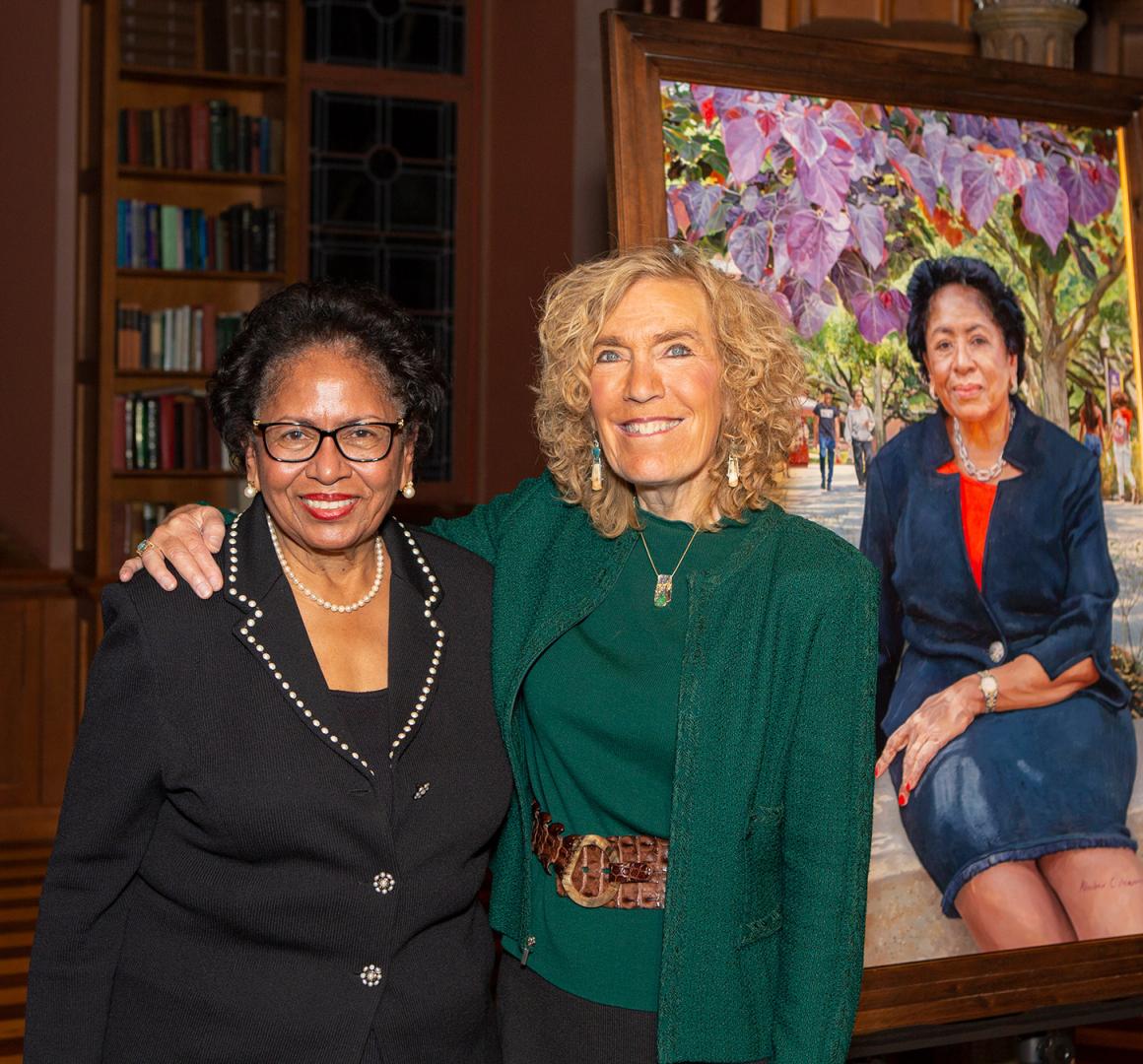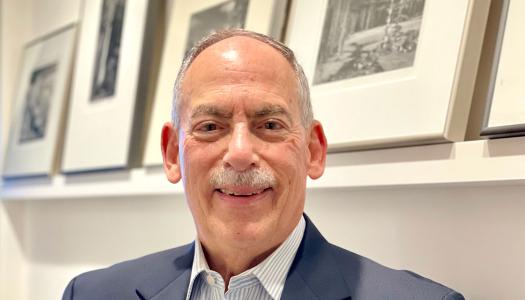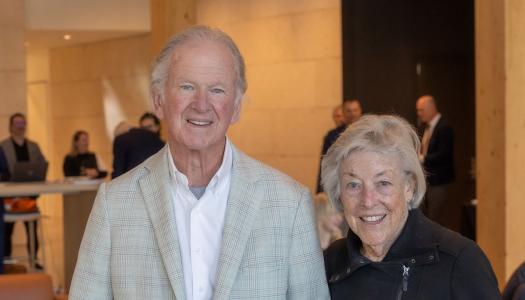Portraits of distinguished Princetonians Ruth Simmons and Elaine Fuchs *77 unveiled

Princeton University unveiled two new portraits on Nov. 16, adding to its permanent art collection and honoring the accomplishments of Princetonians who more fully reflect the diversity of Princeton’s history, its present and its aspirations for the future.
President Christopher L. Eisgruber presided over a ceremony at Chancellor Green unveiling portraits of renowned cell biologist Elaine Fuchs, who earned a Ph.D. in biochemical sciences at Princeton in 1977, and Ruth Simmons, a former Princeton administrator and academic trailblazer who served as the first Black president of an Ivy League institution and is currently president of Prairie View A&M University.
Both honorees attended the ceremony, along with family, friends, members of the nominating committee and many other community members. Shaun Downey, a Toronto-based artist who painted Fuchs’ portrait, also was on hand for the unveiling. Alastair Adams, the British portraitist who completed Simmons’ portrait, was unable to attend.
“On the University campus, we are surrounded by history, literally built into the walls and embodied in the landscape,” said Michele Minter, vice provost for institutional equity and diversity, who delivered the opening remarks. “In recent years, we have recognized and embraced a new commitment to inclusively honor all of those who made Princeton the place that it is today. Since the 19th century, the University’s portrait collection was traditionally limited to former presidents and deans of the graduate and engineering schools. Now, we have begun to make a few, very special expansions to that collection.”
Eisgruber acknowledged the outstanding work of the Portraiture Nominations Committee and recognized the leadership of Treby Williams, Princeton’s executive vice president, who headed the Campus Iconography Committee from 2017 to 2019, and who was in attendance for the unveilings.
In introducing Fuchs, Eisgruber said she “ranks as one of Princeton’s most distinguished alums and the nation’s most preeminent scientists.”
A world-renowned leader in cell biology and molecular genetics, Fuchs’ work on the biology and molecular mechanisms of mammalian skin and skin diseases has helped lead the modernization of dermatology. She is the Rebecca C. Lancefield Professor of Mammalian Cell Biology and Development at The Rockefeller University and an investigator at the Howard Hughes Medical Institute. She has been awarded the National Medal of Science and the University’s James Madison Medal.
Danelle Devenport, associate professor of microbiology at Princeton and one of Fuchs’ more than 70 postdoctoral mentees, gave remarks highlighting Fuchs’ fearless approach to research and her support of young scientists, and of women, in particular.

“She sets expectations high, and then provides all of us with the resources and support needed to succeed,” Devenport said. “And this together creates this really upbeat atmosphere of confident and energetic scientists that collaborate to solve problems rather than compete with one another. It was one of the most invigorating scientific environments that I’ve ever worked in.”
Fuchs called the recognition “a true honor.”
“I’m really enormously grateful to Princeton University for honoring their women in this way,” Fuchs said. “While I’m especially pleased that Princeton chose me amongst the women whose portraits will now adorn its halls, I’m fully aware that the message that Princeton gives here really goes much deeper and broader, and it is to honor all their woman graduates who have pursued their passion and strove to make a difference.”
‘Transformative leader, trailblazer and visionary’
Eisgruber introduced Simmons as a “transformative leader, trailblazer and visionary,” who has had an extraordinary impact on Princeton and on higher education, more broadly.
Prior to becoming president of Prairie View A&M, a historically Black university, Simmons served as president of Smith College and Brown University. As the first woman president of Brown, she also was the first Black president of an Ivy League institution.
As an administrator at Princeton, Simmons served in several pioneering roles, including first director of studies at Butler College and acting director of the Program in African American Studies, and she issued a major report on campus race relations in 1993. She is a former University trustee.
Dean of the Faculty Gene Jarrett gave additional remarks prior to the unveiling of Simmons’ portrait, recounting Simmons’ journey from a daughter of Texas sharecroppers to the highest reaches of the academy. “When and where Ruth Simmons entered the academy, generations of us entered with her,” Jarrett said. “We marveled at her integrity, we basked in her generosity, we heeded her compass.”
Her portrait, he added, while addressing Simmons directly, “can only at best approximate your sublime impact on the world: a world that, despite those very reams of accomplishments of yours, will still lack the capacity to imagine the full expanse of your wisdom, the complete scale of your legacy, the total measure of how much you have meant to the entire world — indeed, how much you have meant to all of us you see here and, even more, to all of those yet unseen.”
Simmons said she could not have imagined her current honor when arriving on Princeton’s campus 40 years ago. “My decision to come to Princeton set my life on a path leading to immensely satisfying challenges, extraordinarily helpful and caring mentors, opportunities to stretch far beyond the Jim Crow era that framed my outlook, and friendships so deep and enduring,” she said. “So before acknowledging the honor the University bestows on me today, I must pay homage to the scores of Princeton administrators, staff, faculty and students who contributed so generously to reframing my outlook and belief in what is possible.”
Fuchs’ portrait will be installed at Icahn Laboratory, while Simmons’ portrait will be placed in Firestone Library.
The University began diversifying its portrait collection in 2017 with commissions honoring Toni Morrison and Sir W. Arthur Lewis, both Nobel laureates. Princeton then announced in 2018 that it would commission eight new portraits, including Fuchs’ and Simmons’, to recognize individuals who, over the past 75 years, have been preeminent in a particular field, who have excelled in the nation’s service and the service of humanity, or have made a significant contribution to the culture of Princeton.
The six others honored in the 2018 commissions are Bill Bradley, Class of 1965; Denny Chin, Class of 1975; Carl A. Fields; Robert J. Rivers, Class of 1953; Sonia Sotomayor, Class of 1976; and Alan M. Turing, a 1938 graduate alumnus.
The portraits of Chin, Fields, Rivers and Turing were dedicated in a ceremony held in 2019. Bradley’s portrait was unveiled on Sept. 9. Plans to unveil Sotomayor’s portrait have yet to be announced.
This story originally was published on the main University website.


